About This Guest Blog Post
As Curator (Collections Knowledge) at Brighton Museum & Art Gallery I’m keen to explore ways we can use web 2.0 again after trialling Facebook, Flickr and MySpace with our Designated Challenge Fund ‘Opening Up Collections’ project for 2006-2008. I was invited to share my experiences of this at the Exploiting the Potential of Web 2.0 UKOLN Workshop for Renaissance West Midlands at The Herbert, Coventry on 26th February 2009. In this guest blog post I describe this work for those who weren’t at the workshop.
Catherine English, Curator (Collections Knowledge), Brighton Museum & Art Gallery
Background to the ‘On the Pull’ project
The On the Pull project was an exciting opportunity for Brighton Museum & Art Gallery to work with target audiences and new ways of researching our collections. Funded by the Designation Challenge Fund (DCF) the project was themed around courtship, attraction and the quest to find the perfect partner, drawing on our Designated collections of World Art, Decorative Art and Natural Science and exploring our Fashion, Local History, Media, Film and Fine Art collections.
Six ‘Researcher/Interpreters’ were recruited to carry out new research and give innovative and creative responses to the museum collections through music, film and writing, teasing out the hidden histories.
Each stage of the project was guided by focus groups comprised of under represented groups in the museum’s visitor profile. They informed research sub themes, gallery interpretation, signage, design, web content, marketing and a programme of events.
The result was a light-hearted look at love and attraction, in terms of both the human experience and in the animal world. In addition to a series of small displays, there was an accompanying programme of events, an interactive area and the use of social networking sites. Visitors could take time to relax in the ‘chill out’ area, record their first dates on a local love map and make their mark in the kissing photo booth.
Using Social Networking Sites
Using social networking sites was not an initial goal. There was a commitment to providing additional interpretation on our museum website but meeting the focus groups made us begin to think about other ways we could give On the Pull an online presence, with the feeling that maybe our collections website would not be the most appropriate place. The first session with the focus groups explored preconceptions of museums and barriers to visiting. The response was that they were thought of as dusty, boring and intimidating places. In this same session we looked at how the members spent their spare time and where they found out about things to do and what was going on around the city. The younger age group (18-24 year olds) spent considerable time looking on line and using sites like MySpace and sending information on word of mouth to friends. We wanted to tap into this and having a MySpace page about On the Pull seemed to be a good place to start.
The ethos of On the Pull was about taking a step away from the traditional museum exhibition to encourage new visitors/target audiences. We began to explore the idea of using social networking sites as a marketing tool and get away from the associations with the word ‘museum’ as a way of breaking down barriers and the connotations the word held to our focus groups. Consequently our marketing was carried out with the web address for the MySpace page, www.myspace/brightononthepull, rather than Brighton Museum. It had links to our main Web site (www.virtualmuseum.info) and links to On the Pull Flickr and Facebook pages too. The focus groups gave us their opinions on colour schemes, designs and also helped choose the title, On the Pull, which we hoped would be something a bit different, short and catchy, and again stepping away from the traditional museum exhibition.
Myspace
Our MySpace page let us add the music and films (linked from YouTube) created by our researchers which were not included in the final displays. We encountered some problems with the subject matter. One of our researchers had produced a film about lobster mating rituals developed around specimens in our natural science collections, when it was added to YouTube it automatically extracted links to similar films to view on YouTube. Some of these were politically problematic, so in the end we had to remove the film.
We included images of the objects the researchers had looked at and used the blog facility to add details about events which were happening throughout the six months On the Pull was up.
We created a persona for our page, which reflected the younger target audience. We became a female, age 22, single, Aquarius, ‘here for networking and friends.’
Flickr
As we were exploring romance related themes we had a photo booth style kissing booth in our interactive area, which visitors could have their photos taken in. These photos were uploaded onto the Flickr pages with a link in the myspace page. I created and monitored the Flickr site. We decided to use Flickr because of its ability to manage many photos. We did not encounter any problems setting up the account with our ICT team as we’re on an open access network with our museum and library service, it also gave us access to Yahoo as you need a yahoo account to open a flickr account. This is something to be aware of when deciding to use these sites.
The photo upload averaged at 1000 images per month, this meant we had to upgrade to a pro account. The pro account gave us unlimited uploads and access to statistics at the cost of $25 a year. It was quick to upload the photos to the site but downloading them manually from kissing booth took time. We encountered some data protection and consent issues which were unique to this project and the images being taken. We had signs up saying the booth was for over 18s only and a message on the screen. You had to agree to the use of your photo on Flickr before the picture was taken. I had to manually upload pictures and use my own judgment over the people’s ages. In a way, as one of the age groups we were targeting were 18 year olds it was a bit of a shame that we may have been excluding their pictures and could have been contradicting what we were trying to do in the first place.
We added keyword tags to all the pictures and arranged them by date in sets. As there were so many we felt this was the best way to organise them, so that people searched through the date they visited the museum to retrieve their picture.
Facebook
We used Facebook in the same way as MySpace as a marketing tool. We advertised our events programme, ran competitions to win free event tickets, displayed promotional images, images of objects from the collections and played music.
We had reservations about using Facebook as you have to join up to use it. However some staff were particularly keen to exploit this as it would allow us to tap into the local networks and our target audience groups, with thousands of members in the local geographical area. We had our own ‘Brighton On the Pull’ group which was open to the Brighton & Hove network; anyone could join and invite others from the local network to join too.
Our overall challenges came from museum management who were concerned about giving us permission to use these sites in the beginning, mainly because they were not sure about how they worked and particularly with the romantic subject matter. It took a lot of effort from me and the project manager to convince them to go ahead. The discussions took up a lot of time and caused some delays on the project.
We weren’t able to add to it all of the time due to staff and time limitations. I think it is important to be quite active and dedicate a lot of time to updating the sites, or maybe have more than one editor, in order for it to evolve. During On the Pull we recruited some volunteer gallery assistants to be meeters and greeters and the friendly face in the gallery our focus group wanted to see. More importantly they were our younger focus group age (18-24 year olds) and most likely used Facebook in their spare time. It would have been great to have them helping out as editors to send out messages in their own voice, keep the pages up-to-date, get people to recommend it to friends and allow it to grow but that meant giving up quite a lot of control of what went on the site. Therefore, we didn’t really have many friends on Facebook, we had slightly more for MySpace but quite a lot of these were local businesses, and a few museums, using these sites in the same way as us.
Focus Groups Feedback
Our focus groups thought that the marketing generally oversold what was on offer and thought it sounded like a single’s night or dating service. Some of the younger group members also said that our MySpace page looked a bit amateurish compared to other MySpace pages.
Because there was so much else happening during the project I feel we didn’t really get the opportunity to evaluate this aspect as much as we would have liked to, maybe because it was a bit of an addition to the main outcomes. We did monitor the amount of friends we had and hits – we had about 6000 hits on the MySpace site for the duration of the project. Flickr was much more popular with 3500 in the first month. The older focus groups (60+ year olds) thought that the MySpace site was for much younger people, but loved the mix of people on Flickr and really welcomed that.
Just as we may have been excluding the younger age group by not adding their kissing booth photo on Flickr, if we had added much more online we could have been excluding the older groups, as they are less likely to use such sites. Flickr was by far the most popular out of the three sites; I think people enjoyed the interaction and being able to look up their photos.
In summary, I’m glad we had the opportunity to explore and experiment with these sites and in the future I would like to see us being a lot more object focussed with using sites like Flickr more proactively to encourage more interaction and social comment on the collections.

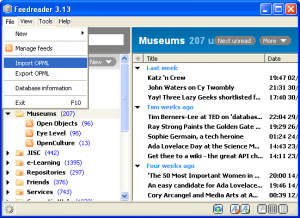
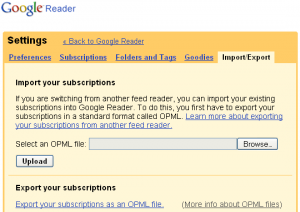
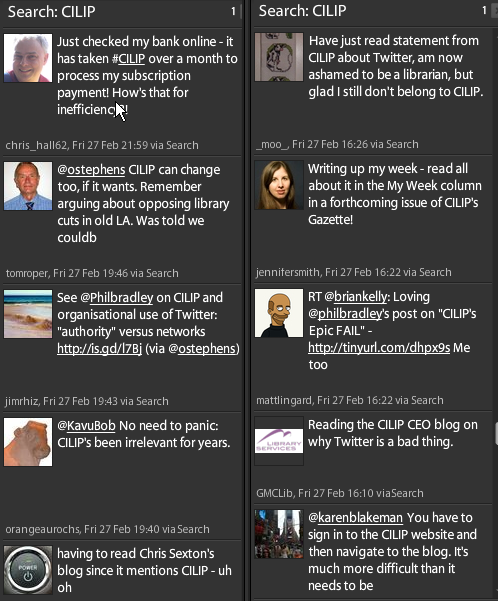
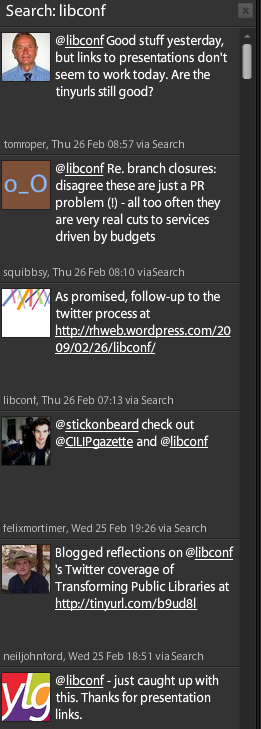

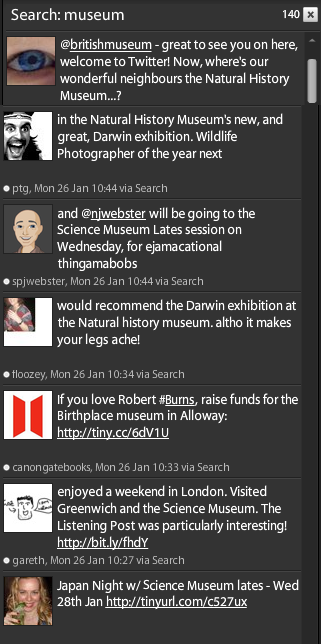 But what is the evidence suggesting about use of Twitter by museums? I recently created a search of Twitter posts (or ‘tweets’ as they are often called) for the term ‘museum’ in my Tweetdeck desktop Twitter client. And, as can be seen from the
But what is the evidence suggesting about use of Twitter by museums? I recently created a search of Twitter posts (or ‘tweets’ as they are often called) for the term ‘museum’ in my Tweetdeck desktop Twitter client. And, as can be seen from the 